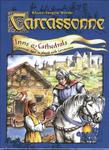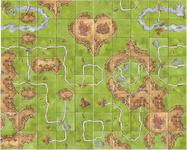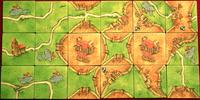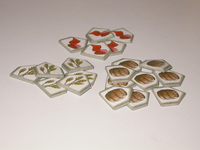

|
Carcassonne is a tile-laying eurogame, which was designed by Klaus-Jurgen Wrede in 2001 and was awarded both the Spiel Des Jahres and the Deutscher SpielePreis that year. Carcassonne is often touted as one of the best “gateway” games (along with Settlers of Catan and Ticket to Ride) for introducing non-gamers to the hobby of strategy board games, and it’s true that the game can definitely be used as a “gateway” game. However, this review is meant to explain how Carcassonne can be played as a deep and heavy game along the lines of Tigris & Euphrates and Caylus. If played under the following conditions, Carcassonne can become a highly strategic and extremely replayable game with no more luck than a game of Tigris.
First things first, what do you get in the box? For a retail price of $24.95, you get the following components: 72 land tiles, 40 wooden followers (a.k.a. “meeples”), 1 scoring track, and 1 instruction booklet. The components are not spectacular, but they get the job done very well and don’t leave anything to be desired. Although the scoring track is not necessarily the best way to keep score because it can get bumped during play and is not as reliable as paper and pencil. I’m going to reference two expansions for Carcassonne below, so I will mention their price and components here as well. First, Carcassonne: Inns & Cathedrals (a.k.a. I&C) retails for $14.95. I&C comes with 18 land tiles, 6 scoring tiles, 8 gray followers, and 6 large followers (a.k.a. “gianteeples”). The new land tiles match the originals nicely, the scoring tiles and gray followers are essentially useless, but the gianteeples are crucial to the game as discussed below. Second, Carcassonne: Traders & Builders (a.k.a. T&B) retails for $14.95 as well. T&B comes with 24 land tiles, 20 trade goods, 6 builders, 6 pigs, 1 cloth bag. All of these components are up to par with the original and are necessary additions to the game. Both of these expansions are a bit pricey, but can be found at discount online retailers for $9.72, which is more reasonable, and are both integral to fully enjoying the game as I think it should be played.



How do you basically play this game? Carcassonne is a tile-laying eurogame, meaning that on each turn your basic action is to draw a random tile from the pool and add it to the board, which starts off with only one tile, but will be composed of 114 tiles by the end of the game. When adding your tile to the board you will have many choices as to where you want to place the tile and how you want to rotate it, but there are some restrictions. In puzzle-like fashion, you have to make sure that like sides match like sides. There are three land features to consider when matching up the sides of the tiles, which are farms, cities, and roads. This is an extremely intuitive system that must people can pick up and understand very quickly because it just feels natural to make sure that the green farms, brown cities, and white roads match up consistently across tiles. After adding your one tile to the board, you can either end your turn right there, or you have the option of placing one of your “meeples” on that tile. If you place a “meeple” on that tile then you have to decide where on the tile he will go. You can turn your “meeple” into farmers on the farms, knights on the cities, thieves on the roads, or monks on the cloisters. Cloisters are the fourth possibility for scoring points in addition to the first three, but are not a feature to consider in making tiles match because they don’t touch the edge of a tile. Play will continue in clockwise order with everyone placing a one tile on their turn and having the option of placing one “meeple” on that tile, until all 114 tiles have been placed, at which point the game ends and final scores are tallied.

How do you score and win this game? You can score points throughout the game as features are completed and you can score additional points at the end of the game for uncompleted features as well as farms. First, roads are the simplest because they give you 1 point per tile and are completed when they have two end points. Roads also give you 1 point per tile at the end of the game even if they are not completed. Second, cities give you 2 points per tile and are completed when they are completely enclosed. However, cities only give you 1 point per tile at the end of the game if they are not completed. Third, cloisters give you 9 points and are completed when they are entirely surrounded by other tiles on all sides (including diagonally). Cloisters give you 1 point per adjacent tile (including diagonally) plus 1 point for the cloister itself at the end of the game if they are not completed. Finally, farms are the most complicated, but also often the most important scoring feature. Farms give you 4 points per completed city that they touch at the end of the game, but do not give you any points during the game. There is also an alternate farm scoring rule that has been designed since Carcassonne was originally released, which involves giving 3 points per completed city, but I will not get into that here because I don’t think it’s as good as the original rules personally.

What does I&C add that’s so important? First, the 18 new land tiles add more possibilities, options, and variety to the base game with new configurations of farms, cities, and roads on them. In addition, these new land tiles add two new features, which are the inns for roads and the cathedrals for cities. Inns make roads worth double, and cathedrals make cities worth three points per tile. However, roads with inns and cities with cathedrals are worth zero at the end of the game if they are not completed. So there is some additional reward but obviously some risk as well. Knowing whether to place the tile with the inn or cathedral on one of your own scoring features to increase your score or whether it's late enough in the game to place the inn or cathedral on an opponent's scoring feature to make it worth nothing in the end is obviously very important, and takes practice to fully appreciate and understand. Second, the large followers (a.k.a. “gianteeples”) are crucial for making the game more strategic. They function like normal meeples except that they count as two meeples for purposes of controlling a scoring feature. While the rules do not permit you to place a meeple on a city, road, or farm that is already claimed, the rules do allow you to place a meeple on a separate city, road, or farm and later join that feature to another feature for purposes of sharing one larger feature. However, if you manage to either join up two meeples then you will take all of the points because you have more meeples on the scoring feature than anyone else. The “gianteeple” is extremely important because it allows you to join up a single nearby city, road, or farm to take control of a valuable scoring feature from your opponent.


What does T&B add that’s so important? First, the 24 new land tiles add even more variety to the base game with even more configurations of farms, cities, and roads on them. Second, the builders are as crucial as the gianteeples for making the game more strategic. The builders are units that you can add to an existing city or road that you are working on, which allow you to immediately take a bonus turn on any future turn that you add to that city or road. These bonus turns really add up, and make clever placement and use of your builder crucial for success in this game. Finally, the trade goods are an important addition to the game because they give you an incentive to complete an opponent’s city sometimes. There are three trade goods (i.e., wine, grain, and cloth), which appear on various city tiles. When you complete a city with tiles that show these goods then you get a marker representing the goods on the tiles. However, you don’t need to actually control and score the city, you just have to lay the last tile that completes the city. At the end of the game, the person with the most markers in each type of trade good receives 10 points. These 30 points awarded at the end of the game can often be decisive, and so you need to constantly monitor the tally of trade goods that you and your opponent have throughout the game.


Finally, these are my tips for making this game as strategic and deep as possible:
1) Three’s a Crowd
Always play with just two players. The game claims to work with anywhere from two to six players (when you add in the I&C expansion), but the game really shines with just two players. With more players there is too much going on between each of your turns, and your level of control diminishes greatly. With only two players, the game becomes zero-sum so that hurting your opponent is just as good as helping yourself, whereas with more players it’s not worthwhile to hurt an opponent’s position because this will simply result in the third player gaining an advantage. The luck of the tile draw is reduced significantly if you can use tiles that don’t help you to simply block and opponent, but doing so is not as good a play when you have multiple opponents. Moreover, with only 2 players you will be able to place 57 tiles during the game, whereas with 3 players you will only be able to place 38 tiles per game. This increased number of tiles placed per game is significant not only because it increases the importance of managing your supply of meeples so that you never have too few in your supply but you never have too few on the board, but also because it reduces the luck of the tile draw by increasing the number of tiles drawn. I’m not statistics expert, but I’m pretty sure that the larger the sample size, the more likely that your distribution is not skewed, so in a two-player game you are less likely to draw all of one type of tile for example.
2) Vanilla is just too Plain
Always play with both the I&C and T&B expansions. Not only are the additional 42 tiles crucial for adding variety to the tile mix, but also the two new unites (i.e., gianteeples and builders) add a significant layer of strategy to the game. Using your gianteeple and builder effectively is crucial to success. First, the gianteeple is critical because it facilitates stealing cities, roads, and farms from your opponent, so the game becomes much more about clever placement to take over an opponent’s scoring feature or to block an opponent from stealing your valuable scoring features. Moreover, if you can lock-up your opponent’s gianteeple early in the game in a position that is unlikely to allow your opponent to reclaim the gianteeple then you will often win, so it is very important to prevent your gianteeple from getting trapped on the board. Second, the builder is also critical because maximizing your number of bonus turns is extremely important to winning. It’s pretty clear that someone who takes twice as many turns as their opponent will almost always win, so if you are constantly adding to the scoring feature with your builder then you will do very well, and if you can trap your opponent’s builder on the board where he cannot add to the builder’s scoring feature then you will also do very well. Deciding whether to place your builder on a road or a city is very important, and deciding whether to complete the feature with your builder on it to reclaim the unit and replace it elsewhere is also a very interesting decision.
3) There’s no such thing as too Aggressive
The most important thing for making Carcassonne as deep and highly strategic game is to play as aggressively as possible. This means that you need to realize that stealing an opponent’s city, road, or farm is often much better than simply starting your own. This means that you need to always be conscious of how your opponent may try to steal your own cities, roads, and farms, and you need to try to build these scoring features so as to minimize his opportunities for sneaking onto your features. You should constantly be thinking about how to get meeples into your opponent’s cities, roads, and farms, especially once the cities are a couple tiles big, the roads are a few tiles long, and the farms are worth more than 12 or so points. In addition, if you draw a tile that isn’t much use to you because you can’t add it to anything you’re working on and you’re not in a position to start something new, then you should absolutely find the best place to play it to block your opponent. You should even think about block your opponent even if the tile could be used to help yourself because in a two-player game hurting your opponent is often as good or better than helping yourself. This means that you should minimize the number of tiles that would work for your opponent in a specific situation. If he needs one tile to complete a city then trying to place tiles adjacent to the space where he needs to place that final city tile. You should dictate whether the edges of that final city tile must have roads or farms on them so as to minimize his chances of completing the city. This is even more important if the city has either his gianteeple or builder in it. If you simply work on your own scoring features, ignoring what your opponent is doing, not only will the game not be very interesting or interactive, but you will lose consistently.
 Enjoy Carcassonne!
Enjoy Carcassonne! 
(See this Review for this article plus additional comments on it)